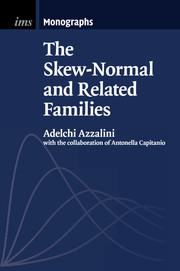Book contents
- Frontmatter
- Contents
- Preface
- 1 Modulation of symmetric densities
- 2 The skew-normal distribution: probability
- 3 The skew-normal distribution: statistics
- 4 Heavy and adaptive tails
- 5 The multivariate skew-normal distribution
- 6 Skew-elliptical distributions
- 7 Further extensions and other directions
- 8 Application-oriented work
- Appendix A Main symbols and notation
- Appendix B Complements on the normal distribution
- Appendix C Notions on likelihood inference
- References
- Index
1 - Modulation of symmetric densities
Published online by Cambridge University Press: 18 December 2013
- Frontmatter
- Contents
- Preface
- 1 Modulation of symmetric densities
- 2 The skew-normal distribution: probability
- 3 The skew-normal distribution: statistics
- 4 Heavy and adaptive tails
- 5 The multivariate skew-normal distribution
- 6 Skew-elliptical distributions
- 7 Further extensions and other directions
- 8 Application-oriented work
- Appendix A Main symbols and notation
- Appendix B Complements on the normal distribution
- Appendix C Notions on likelihood inference
- References
- Index
Summary
Motivation
This book deals with a formulation for the construction of continuous probability distributions and connected statistical aspects. Before we begin, a natural question arises: with so many families of probability distributions currently available, do we need any more?
There are three motivations for the development ahead. The first motivation lies in the essence of the mechanism itself, which starts with a continuous symmetric density function that is then modified to generate a variety of alternative forms. The set of densities so constructed includes the original symmetric one as an ‘interior point’. Let us focus for a moment on the normal family, obviously a case of prominent importance. It is well known that the normal distribution is the limiting form of many non-normal parametric families, while in the construction to follow the normal distribution is the ‘central’ form of a set of alternatives; in the univariate case, these alternatives may slant equally towards the negative and the positive side. This situation is more in line with the common perception of the normal distribution as ‘central’ with respect to others, which represent ‘departures from normality’ rather than ‘incomplete convergence to normality’.
The second motivation derives from the applicability of the mechanism to the multivariate context, where the range of tractable distributions is much reduced compared to the univariate case. Specifically, multivariate statistics for data in Euclidean space is still largely based on the normal distribution.
- Type
- Chapter
- Information
- The Skew-Normal and Related Families , pp. 1 - 23Publisher: Cambridge University PressPrint publication year: 2013

